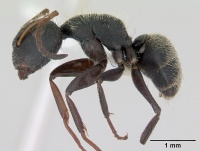Camponotus brettesi
| Camponotus brettesi | |
|---|---|

| |
| Scientific classification | |
| Kingdom: | Animalia |
| Phylum: | Arthropoda |
| Class: | Insecta |
| Order: | Hymenoptera |
| Family: | Formicidae |
| Subfamily: | Formicinae |
| Tribe: | Camponotini |
| Genus: | Camponotus |
| Species: | C. brettesi |
| Binomial name | |
| Camponotus brettesi Forel, 1899 | |
| Subspecies | |
| |
Gillette et al. (2015) in a Chaipas, Mexico field study of twig-nesting ants in coffee plants found C. brettesi nesting within one sampled plot of plants at 750m.
Identification
Distribution
Latitudinal Distribution Pattern
Latitudinal Range: 20.85574444° to 10.35°.
| North Temperate |
North Subtropical |
Tropical | South Subtropical |
South Temperate |
- Source: AntMaps
Distribution based on Regional Taxon Lists
Neotropical Region: Costa Rica, Ecuador, Guatemala (type locality), Honduras, Mexico, Panama, Trinidad and Tobago.
Distribution based on AntMaps
Distribution based on AntWeb specimens
Check data from AntWeb
Countries Occupied
| Number of countries occupied by this species based on AntWiki Regional Taxon Lists. In general, fewer countries occupied indicates a narrower range, while more countries indicates a more widespread species. |

|
Estimated Abundance
| Relative abundance based on number of AntMaps records per species (this species within the purple bar). Fewer records (to the left) indicates a less abundant/encountered species while more records (to the right) indicates more abundant/encountered species. |

|
Biology
Castes
Nomenclature
The following information is derived from Barry Bolton's Online Catalogue of the Ants of the World.
- brettesi. Camponotus brettesi Forel, 1899c: 141 (s.w.) GUATEMALA, COSTA RICA, COLOMBIA.
- Type-material: syntype major and minor workers (numbers not stated).
- Type-locality: Guatemala: (no further data) (Champion) (invalid restriction of type-locality by Kempf, 1972a: 50; no lectotype designated), Costa Rica: (no further data) (A. Tonduz), Colombia: Sierra Nevada de Santa Marta, 17.ii.-17.iii.1896 (A. Forel).
- [Note: Forel’s Neotropical itinerary is outlined in Forel, 1902b: 170.]
- Type-depository: MHNG.
- Combination in C. (Myrmobrachys): Forel, 1914a: 270.
- Status as species: Forel, 1902b: 171; Forel, 1905b: 160; Wheeler, W.M. 1905b: 133; Wheeler, W.M. 1922c: 16; Emery, 1925b: 163; Wheeler, W.M. 1942: 257; Kempf, 1972a: 50; Bolton, 1995b: 89; Branstetter & Sáenz, 2012: 255.
- Distribution: Colombia, Costa Rica, Guatemala, Trinidad, Venezuela.
- Current subspecies: nominal plus canalis.
Description
References
- Baena, M.L., Escobar, F., Valenzuela, J.E. 2019. Diversity snapshot of green–gray space ants in two Mexican cities. International Journal of Tropical Insect Science 40, 239–250 (doi:10.1007/s42690-019-00073-y).
- Forel, A. 1899i. Formicidae. [concl.]. Biol. Cent.-Am. Hym. 3: 137-160 (page 141, worker described)
- Forel, A. 1914a. Le genre Camponotus Mayr et les genres voisins. Rev. Suisse Zool. 22: 257-276 (page 270, combination in C. (Myrmobrachys))
- Gillette, P. N., K. K. Ennis, G. D. Martinez, and S. M. Philpott. 2015. Changes in Species Richness, Abundance, and Composition of Arboreal Twig-nesting Ants Along an Elevational Gradient in Coffee Landscapes. Biotropica. 47:712-722. doi:10.1111/btp.12263
References based on Global Ant Biodiversity Informatics
- Dattilo W. et al. 2019. MEXICO ANTS: incidence and abundance along the Nearctic-Neotropical interface. Ecology https://doi.org/10.1002/ecy.2944
- De la Mora, A., J. A. Garcia-Ballinas, and S. M. Philpott. 2015. Local, landscape, and diversity drivers of predation services provided by ants in a coffee landscape in Chiapas, Mexico. Agriculture, Ecosystems & Environment 201: 83-91.
- Forel A. 1902. Quatre notices myrmécologiques. Annales de la Société Entomologique de Belgique 46: 170-182.
- Forel A. 1905. Miscellanea myrmécologiques II (1905). Ann. Soc. Entomol. Belg. 49: 155-185.
- Jeanne R. J. 1979. A latitudinal gradient in rates of ant predation. Ecology 60(6): 1211-1224.
- Kempf, W.W. 1972. Catalago abreviado das formigas da regiao Neotropical (Hym. Formicidae) Studia Entomologica 15(1-4).
- Longino J. T. 2013. Ants of Honduras. Consulted on 18 Jan 2013. https://sites.google.com/site/longinollama/reports/ants-of-honduras
- Longino J. et al. ADMAC project. Accessed on March 24th 2017 at https://sites.google.com/site/admacsite/
- Maes, J.-M. and W.P. MacKay. 1993. Catalogo de las hormigas (Hymenoptera: Formicidae) de Nicaragua. Revista Nicaraguense de Entomologia 23.
- Vásquez-Bolaños M. 2011. Lista de especies de hormigas (Hymenoptera: Formicidae) para México. Dugesiana 18: 95-133
- Wheeler W. M. 1905. The ants of the Bahamas, with a list of the known West Indian species. Bulletin of the American Museum of Natural History 21: 79-135.
- Wheeler W. M. 1922. The ants of Trinidad. American Museum Novitates 45: 1-16.
- Wheeler W. M. 1942. Studies of Neotropical ant-plants and their ants. Bulletin of the Museum of Comparative Zoology 90: 1-262.

